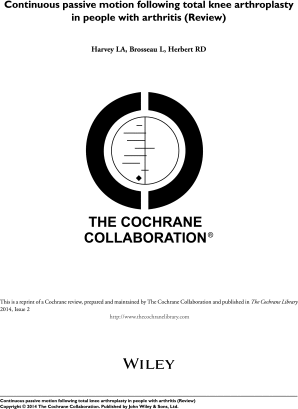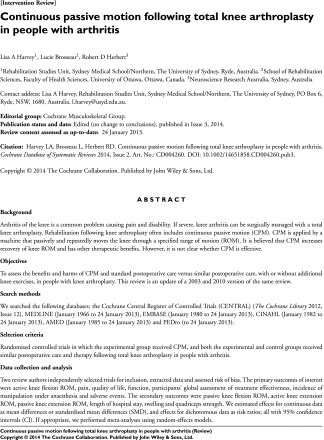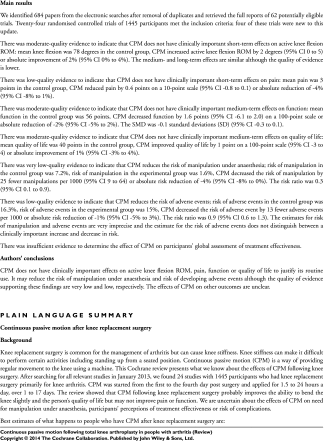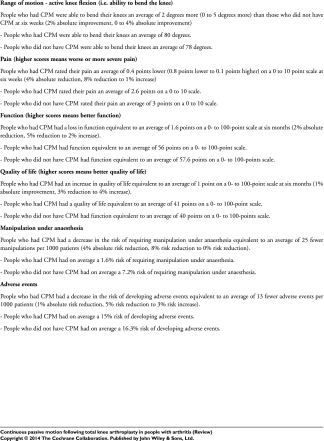Importance of the Topic
Total knee arthroplasty (TKA) effectively reduces pain and improves function in most patients. It is also one of the most commonly performed orthopaedic procedures [7]; one projection suggests that in the United States alone, more than 1.3 million TKAs will be performed per year by 2020 [12]. However, knee stiffness complicates approximately 1.3% of TKAs, severely limiting patients’ function [11], reducing quality of life, and resulting in early revision [13].
Continuous Passive Motion (CPM) refers to the use of a motorized device that is applied to a patient’s lower extremity, and continuously moves the patient’s knee through a predefined arc of motion [8]. This device is typically used during the immediate postoperative period, and it has been theorized that early passive range-of-motion (ROM) can prevent the formation of adhesions that cause joint stiffness [15]. However, the cost of CPM devices can be high, and the efficacy of CPM is uncertain. This Cochrane systematic review and meta-analysis evaluated the efficacy of CPM in patients undergoing primary TKA [8]. Based on evidence from 24 randomized trials (pooled n = 1445), the authors concluded that there is very little advantage of using CPM after TKA.
Upon Closer Inspection
This review used the Grading of Recommendations Assessment, Development and Evaluation (GRADE) approach to rate confidence in the pooled outcomes. The highest rating given was “moderate” confidence for three outcomes: Active knee flexion at 6 weeks (10 studies); function at 6 months (six studies); and quality of life at 6 months (two studies). For each of these outcomes, no significant differences were detected between the CPM and control groups.
While CPM was shown to be advantageous in reducing the proportion of patients undergoing manipulation under anesthesia at 6 weeks followup (the only endpoint for which CPM was found to be effective), this finding received a GRADE confidence rating of “very low” due to imprecision of the pooled effect estimate, lack of blinding in trials reporting this outcome, and high level of heterogeneity among trials. Another possible explanation for this finding is changes in practice patterns over time. None of the trials published after the year 2000 favored CPM as an effective means to reduce the likelihood a patient will undergo manipulation under anesthesia, so it is possible that newer rehabilitation protocols or changing surgeon preferences pertaining to manipulation under anesthesia could have nullified the effects demonstrated in earlier trials [6, 14].
Take-Home Messages
The conclusions of this Cochrane review are consistent with previous systematic reviews [4], as well as recent recommendations of the American Physical Therapy Association to avoid use of CPM following TKA [1]. Two recently published randomized trials [3, 9] that were not included in this review have corroborated these conclusions as well, demonstrating no benefit for CPM over conventional physiotherapy. However, a poll taken at the American Association of Hip and Knee Surgeons annual meeting in 2009 demonstrated that the majority of orthopaedic surgeons (58%) used CPM following TKA [2], and no official recommendations pertaining to CPM have yet been made by any major American orthopaedic organization. Given its lack of efficacy as demonstrated in this Cochrane review, clinicians should consider discontinuing the routine use of CPM as an adjunct to standard physiotherapy following uncomplicated primary TKA and orthopaedic surgery clinical practice guidelines should consider incorporating this evidence into their recommendations.
Importantly, trials within this review predominantly included cases of uncomplicated primary TKA. Thus, the results of this review do not necessarily apply to other procedures of the knee, including revision TKAs, or to cases with unique considerations where clinical judgment is still important. For instance, some surgeons believe CPM is important after manipulation under anesthesia given the high risk for recurrence of joint adhesions and stiffness [5, 10]. Further research is required to determine whether there are specific indications where CPM may be beneficial following TKA.
Appendix




Footnotes
A Note from the Editor-In-Chief: We are pleased to publish the next installment of Cochrane in CORR ® , our partnership between CORR ® , The Cochrane Collaboration ® , and McMaster University’s Evidence-Based Orthopaedics Group. In it, researchers from McMaster University and other institutions will provide expert perspective on an abstract originally published in The Cochrane Library that we think is especially important.
(Harvey LA, Brosseau L, Herbert RD. Continuous passive motion following total knee arthroplasty in people with arthritis. Cochrane Database of Systematic Reviews 2014, Issue 2. Art. No.: CD004260. DOI:10.1002/14651858.CD004260.pub3).
Copyright © 2014 The Cochrane Collaboration. Published by John Wiley & Sons, Ltd. Reproduced with permission.
The authors certify that they, or any members of their immediate families, have no funding or commercial associations (eg, consultancies, stock ownership, equity interest, patent/licensing arrangements, etc.) that might pose a conflict of interest in connection with the submitted article.
All ICMJE Conflict of Interest Forms for authors and Clinical Orthopaedics and Related Research ® editors and board members are on file with the publication and can be viewed on request.
The opinions expressed are those of the writers, and do not reflect the opinion or policy of CORR ® or the Association of Bone and Joint Surgeons®.
Cochrane Reviews are regularly updated as new evidence emerges and in response to feedback, and The Cochrane Library (http://www.thecochranelibrary.com) should be consulted for the most recent version of the review.
This Cochrane in CORR® column refers to the abstract available at DOI:10.1002/14651858.CD004260.pub3.
References
- 1.American Physical Therapy Association. Five things physical therapists and patients should question. Available at: http://www.apta.org/ChoosingWisely/5Things/. Accessed July 23, 2015.
- 2.Berry DJ, Bozic KJ. Current practice patterns in primary hip and knee arthroplasty among members of the American Association of Hip and Knee Surgeons. J Arthroplasty. 2010;25:2–4. doi: 10.1016/j.arth.2010.04.033. [DOI] [PubMed] [Google Scholar]
- 3.Boese CK, Weis M, Phillips T, Lawton-Peters S, Gallo T, Centeno L. The efficacy of continuous passive motion after total knee arthroplasty: A comparison of three protocols. J Arthroplasty. 2014;29:1158–1162. doi: 10.1016/j.arth.2013.12.005. [DOI] [PubMed] [Google Scholar]
- 4.Brosseau L, Milne S, Wells G, Tugwell P, Robinson V, Casimiro L, Pelland L, Noel MJ, Davis J, Drouin H. Efficacy of continuous passive motion following total knee arthroplasty: A metaanalysis. J Rheumatol. 2004;31:2251–2264. [PubMed] [Google Scholar]
- 5.Esler CNA, Lock K, Harper WM, Gregg PJ. Manipulation of total knee replacements: Is the flexion gained retained? J Bone Joint Surg Br. 1999;81-B:27–29. [DOI] [PubMed]
- 6.Fitzsimmons SE, Vazquez EA, Bronson MJ. How to treat the stiff total knee arthroplasty? A systematic review. Clin Orthop Relat Res. 2010;468:1096–1106. doi: 10.1007/s11999-010-1230-y. [DOI] [PMC free article] [PubMed] [Google Scholar]
- 7.Garrett WE, Swiontkowski MF, Weinstein JN, Callaghan J, Rosier RN, Berry DJ, Harrast J, Derosa GP. American Board of Orthopaedic Surgery practice of the orthopaedic surgeon: Part-II, certification examination case mix. J Bone Joint Surg Am. 2006;88:660–667. doi: 10.2106/JBJS.E.01208. [DOI] [PubMed] [Google Scholar]
- 8.Harvey LA, Brosseau L, Herbert RD. Continuous passive motion following total knee arthroplasty in people with arthritis. Cochrane Database of Systematic Reviews. 2014;2:CD004260. doi: 10.1002/14651858.CD004260.pub3. [DOI] [PMC free article] [PubMed] [Google Scholar]
- 9.Herbold JA, Bonistall K, Blackburn M, Agolli J, Gaston S, Gross C, Kuta A, Babyar S. Randomized controlled trial of the effectiveness of continuous passive motion after total knee replacement. Arch Phys Med Rhabil. 2014;95:1240–1245. doi: 10.1016/j.apmr.2014.03.012. [DOI] [PubMed] [Google Scholar]
- 10.Ingmar I, Mittag F, Lahrmann J, Kunze B, Kluba T. Arthrofibrosis after TKA – influence factors on the absolute flexion and gain in flexion after manipulation under anaesthesia. BMC Musculoskelet Disord. 2011;12:184. doi: 10.1186/1471-2474-12-184. [DOI] [PMC free article] [PubMed] [Google Scholar]
- 11.Kim J, Nelson CL, Lotke PA. Stiffness after total knee arthroplasty. Prevalence of the complication and outcomes of revision. J Bone Joint Surg Am. 2004;86-A:1479–1484. [PubMed] [Google Scholar]
- 12.Kurtz SM, Ong KL, Lau E, Bozic KJ. Impact of the economic downturn on total joint replacement demands in the United States: Updated projections to 2021. J Bone Joint Surg Am. 2014;96:624–630. doi: 10.2106/JBJS.M.00285. [DOI] [PubMed] [Google Scholar]
- 13.Le DH, Goodman SB, Maloney WJ, Huddleston JI. Current modes of failure in TKA: Infection, instability, and stiffness predominate. Clin Orthop Relat Res. 2014;472:2197–2200. doi: 10.1007/s11999-014-3540-y. [DOI] [PMC free article] [PubMed] [Google Scholar]
- 14.Ranawat AS, Ranawat CS. Pain management and accelerated rehabilitation for total hip and knee arthroplasty. J Arthroplasty. 2007;22:12–15. doi: 10.1016/j.arth.2007.05.040. [DOI] [PubMed] [Google Scholar]
- 15.Salter RB. The biologic concept of continuous passive motion of synovial joints. The first 18 years of basic research and its clinical application. Clin Orthop Relat Res. 1989;242:12–25. [PubMed] [Google Scholar]


